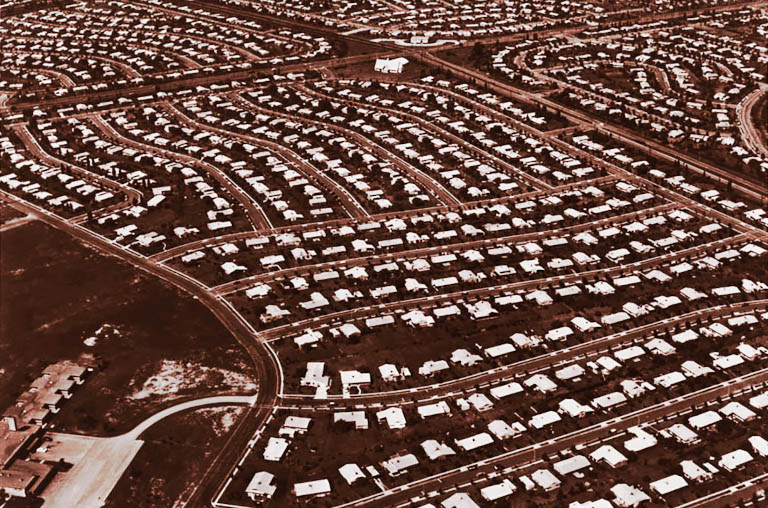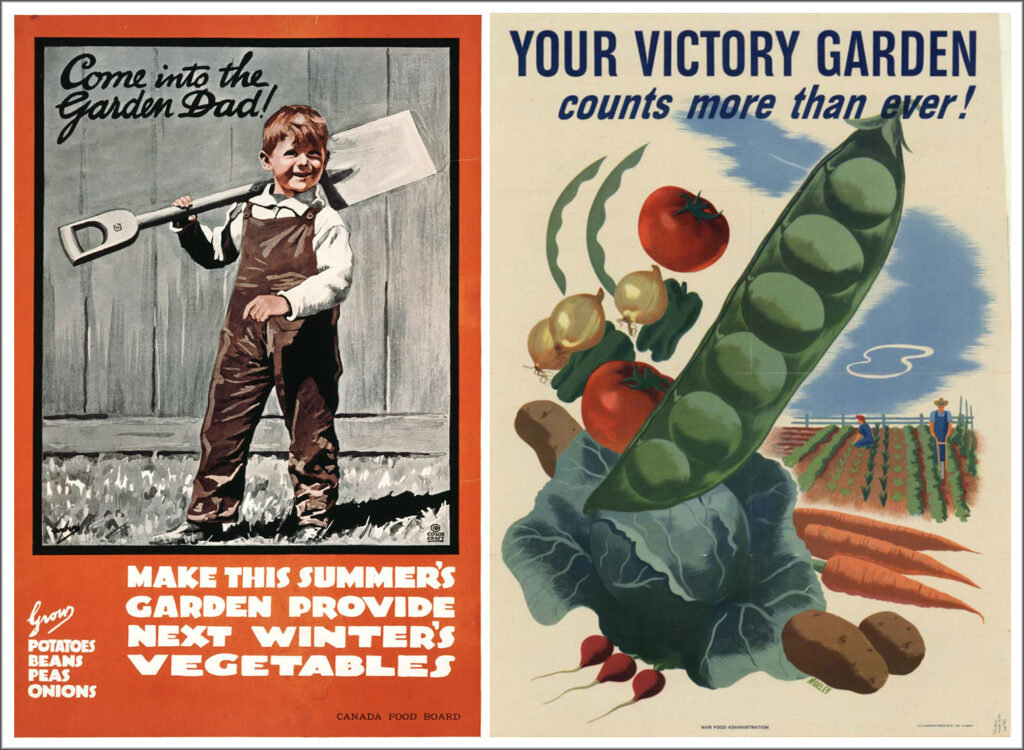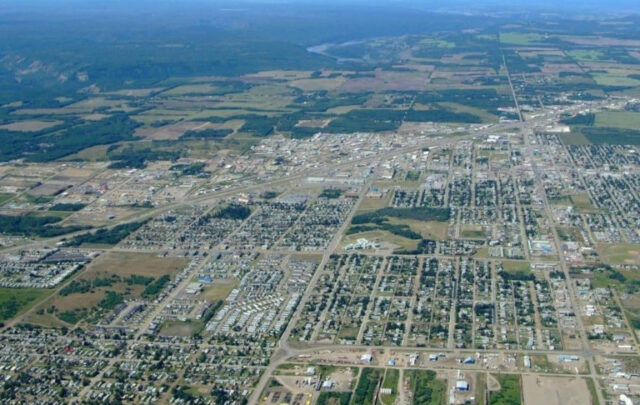Social critic James Howard Kunstler referred to suburban sprawl as “the greatest misallocation of resources in history.”1 In his view, “The suburbs have three destinies – as slums, salvage yards, and ruins.”2
While agreeing that suburbs in their current form are “hopelessly maladapted to the coming world of energy descent,” permaculture pioneer David Holmgren nevertheless believes that
“Low-density detached housing with gardens is the ideal place for beginning a bottom-up revolution to recreate the household and community non-monetary economies that our recent forebears took for granted as the basis for an adequate, even comfortable, life.”3
Suburbs have not come to an end – in my region, in fact, they are still adding suburban sprawl like there’s no tomorrow. Signs of positive transformations of suburban developments exist across North America, but you might need to look carefully to notice.
This post will look at some of those signs of transformation and how they might be accelerated. In contrast to the last post, Can car-dependent suburbs become walkable communities?, this post and the next will focus mostly on small-scale initiatives.
The major theme of this series of posts has been the contrast between car-dependency and walkable communities. Walkability is a transportation issue, of course, but it is more than that.
It is often said that transportation planning and land use planning are two sides of the same coin.4 It’s important to look at both issues, not only as they are addressed in government policies, but also as they are addressed by individuals or small groups of neighbours.
For the purposes of this discussion, three key features of suburbia are:
- zoning rules that mandate the separation of residential districts from commercial districts and industrial districts;
- the default assumption that people will drive cars from their homes to workplaces, stores, cultural events, and recreational facilities; and
- the organization of the resulting car traffic into maze-like local residential streets, larger collector streets, six-to-eight lane major arterials, and expressways.
These basic parameters have many implications as discussed in previous posts. The practice of driving everywhere means there also needs to be parking at every location, so that a typical suburban district has several parking spaces for every car. (See How parking ate North American cities.)
The funneling of traffic to bigger but more widely spaced roads leads to traffic jams during every rush hour, and dangerous speeding when traffic volumes are low. The dangerous collector and arterial roads put vulnerable road users, such as pedestrians and cyclists, at risk of death or serious injury in getting from their own immediate neighbourhoods to other neighbourhoods. (See Building car-dependent neighbourhoods).
And the low residential and employment density of sprawl makes it difficult and expensive to build public transit systems that run frequently and within a short walk of most residents. The result is that suburban sprawl seldom has good transit, which in turn strongly reinforces car-dependency. (See Recipes for car dependency.)
Change will not be optional
Notwithstanding the difficulties of transforming the suburban pattern, I believe it will happen for this simple reason:
That which is not sustainable will not be sustained.
First, suburban sprawl is not financially sustainable, particularly in the governance arrangements we have in North America. As Strong Towns has demonstrated through numerous articles, podcasts and videos, North American suburban expansion has been a Ponzi scheme. While expansion infrastructure is usually paid for through a combination of federal government and developer funding, local municipalities are left with the liabilities for infrastructure maintenance and eventual replacement. That wouldn’t be a problem if the new districts could raise sufficient property tax revenue to cover these liabilities. But they don’t.
Low-density housing tracts, interspersed with one-story shopping centers and strip malls, all surrounded by expansive parking, don’t bring in nearly as much property tax/acre as denser, multi-story developments in older downtown districts do. The low tax revenue, coupled with very high maintenance-replacement liabilities for extensive roadways, parking lots, and utilities, eventually catch up with municipalities. And then? Some can keep the game going, simply by getting more funding grants for even further sprawl – thus the “Ponzi scheme” moniker – but eventually they run out of room to expand.
As Charles Marohn has written,
“Decades into this experiment, American cities have a ticking time bomb of unfunded liability for infrastructure maintenance. The American Society of Civil Engineers (ASCE) estimates deferred maintenance at multiple trillions of dollars, but that’s just for major infrastructure, not the local streets, curbs, walks, and pipes that directly serve our homes.”5
Worth noting is that as climate instability forces infrastructure reconstructions to happen more frequently and to higher standards, the pressure on municipal governments will be even more intense. And as energy costs spike higher, fewer residents will be able to afford the long commutes in private cars that they now take for granted.
When suburban municipalities face bankruptcy, what will the choices be? Certainly one choice is to abandon some areas to become, in Kunster’s words “slums, salvage yards, and ruins.” For reasons explained below, I think it’s more likely that municipalities will allow more varied and denser developments than are currently permitted by zoning codes, so that a larger property tax base can help cover infrastructure liabilities.
Suburban sprawl is also likely to prove unsustainable at the level of individual homes. Debt has grown rapidly in recent decades, and a great deal of that debt is in the form of mortgages by homeowners – many of whom live in the far reaches of suburbia.
Jeff Speck wrote “The typical American working family now lives in suburbia, where the practice of drive-’til-you-qualify reigns supreme.”6 Due to a dearth of affordable homes inside American cities (and in Canadian cities as well), new home buyers have only been able to qualify for mortgages far from urban cores. The price for somewhat cheaper housing, however, is that each working member of the family is likely to need a car to get to and from work. In Speck’s words,
“The average American family now spends about $14,000 per year driving multiple cars. … Remarkably, the typical ‘working’ family, with an income of $20,000 to $50,000, pays more for transportation than for housing.”7
When families are paying for the biggest mortgage they qualify for plus the cost of keeping two or more cars on the road, the shock of higher interest rates, a rise in unemployment, and/or higher gas costs can be too much to sustain. Referring to the 2007-2009 oil price spike and economic downturn, Speck explains that “as gasoline broke $4.00 per gallon and the housing bubble burst, the epicenter of foreclosures occurred at the urban periphery.”8
In coming economic crises, on a collective scale or an individual scale, I wouldn’t expect the suburbs to be abandoned or to be torn down en masse and rebuilt. Frankly, I don’t expect society to be wealthy enough to simple start over in other places or following other patterns. Instead, I would expect both municipal governments and individuals to muddle through by making a wide range of adjustments. And some of those are starting already.
The household as a place of production, not just consumption
As Samuel Alexander and Brendan Gleeson have written,
“Built environment change is slow and contested. In a developed city, turnover (additions and alterations) in the built stock is typically much less than five per cent per annum.”9
But while buildings, lots and streets may change slowly, the activities that go on there may change more rapidly.
One significant change has been happening already, in spite of zoning rules that typically disallow the change.
In a post titled “Your Home Office Might Be Illegal,” Edward Erfurt wrote,
“The frontline zoning battle for the right to work out of your home hit center stage during COVID. Under most zoning codes, we are all breaking the law.”10
He adds that
“Working from home and working out of a home has become normalized. … Others have even taken the next incremental step of leaving a corporate job to open a new business in our homes.”
Simply turning a blind eye to zoning violations is one thing, but Erfurt urges municipalities to take a proactive approach:
“Home Occupations should be permitted by right in every zoning category in your community. Whether you are working remotely for a large corporation or running your own business, you should have the right to do this within your home. Cities should encourage home occupations as a tenet of their economic development strategy, and a single line could be added to any code to focus the planners.”
Robert Rice describes how the dynamic is now playing out in Houston:
“This is how the Suburban Experiment really ends: not with explosive legislation, but with regular people making the best of what they have. In Houston, what we have is houses. I propose that these new house-businesses, home offices, and de-facto multifamily residences are the first increment of intensity for a suburban neighborhood.”11
Some of these changes are taking place in accord with current law and some in defiance of current law. However, many jurisdictions across North America are now changing rules to allow modestly greater density in residential areas, including in suburbs. Travis Beck recently wrote:
“Minneapolis, for example, ended single-family zoning effective January 2020, allowing the construction of duplexes and triplexes on all residential lots. Oregon passed legislation in 2019 requiring cities with populations above 25,000 to allow construction of duplexes, triplexes, and fourplexes on all residential lots. And California’s 2021 Senate Bill 9 allows the construction of duplexes on residential lots and the splitting of sufficiently large lots into two parcels, effectively allowing four housing units to be built in place of one.”12
Even the province of Ontario, infamous for bungled attempts to enrich land speculators by fast-tracking sprawl on previously protected lands, recent legislation specifies that
“up to three residential units are permitted ‘as of right’ on most land zoned for one home in residential areas without needing a municipal by-law amendment.”13
Intermittent additions of one or two residences per lot may seem insignificant compared with the scope of the housing crisis; such zoning changes are certainly not sufficient to make suburbia sustainable. Yet such changes provide for greater flexibility in housing options and promote actions by individual property owners and small contractors, in contrast to the large developers who are often spoken of as the only actors who can solve the housing crisis. Paradoxically, the pace of densification on a lot-by-lot basis could pick up in an economic downturn, if significant numbers of homeowners decide it make sense to downsize their overly-large residences by creating one or two rental units.
It’s not only the number of residential units and the number of residences that matter, but also the kinds of activities that happen in residential neighbourhoods. As discussed above, a large number of suburban homes are now de facto workplaces. The work done in and around homes, whether or not that work is counted in official economic statistics, could become a greater factor in the suburban economy.
The Victory Garden movements of the last century encouraged people to raise food in their own yards, whether they lived in cities, the nascent suburbs, small towns or rural areas. In the US, during WW I about one-third of US vegetables came from Victory Gardens. By 1943 during WW II, there were 12 million Victory Gardens in cities. A Wikipedia article notes that
“While Victory Gardens were portrayed as a patriotic duty, 54% of Americans polled said they grew gardens for economic reasons while only 20% mentioned patriotism.”
(Image on left is a WWI-era poster from Canada; at right is WWII image from use. Images and data from Wikipedia article Victory garden.)
One of the key features of most suburbs, visible from the street or from the air, is the small- or medium-size plot of lawn adjacent to each single-family dwelling. But the biological desert of the standard lawn can easily be replaced with something much more life-giving. Alexander and Gleeson write:
“Digging up backyards and front yards and planting fruit and vegetables, keeping chickens, and composting, are important practices, reconnecting people with the seasons, the soil, and the food on their plates. In the words of permaculture activist and educator, Adam Grubb, we should ‘eat the suburbs’.”14
A frequent objection to this idea is that few people could raise all their own food on a typical suburban lot. Quite true, and quite beside the point. More relevant is that many and perhaps most suburban residents could raise a significant portion of their fruits, vegetables, herbs, eggs, and other foods if they choose. In the process, they and their communities would become more resilient while promoting greater local biodiversity.
Suburban landscapes often include many other strips of green, kept semi-alive through regular mowing and sometimes watering: strips between areas of parking lots, in front of strip malls, on medians within major arterials, within the “cloverleafs” of expressway interchanges. Alexander and Gleeson invite us to imagine the transformation of these areas:
“Over time, we can imagine food production crossing beyond household boundaries, too, re-commoning public space. This is already under way, as people reclaim nature strips for food production, plant fruit trees in the neighborhood, establish community gardens, and cultivate unused land through “guerrilla gardening.’”15
Alexander and Gleeson write in an Australian context. In North America, a great example of similar change is the work of permaculture proponent Jan Spencer in Eugene, Oregon. Over the past twenty-three years he has transformed his quarter-acre suburban lot into an oasis. Starting with an 1,100 square foot home fronted by a driveway big enough to park six cars, Spencer gradually turned the driveway and surrounding spaces into three-dimensional gardens, added enough water tanks to collect thousands of gallons of rainwater to keep his gardens happy through the typically dry local summer, and built a 400 square foot living space for himself so he could rent out three rooms in the house.16
As Spencer explains, a key permaculture principle is to design each change so that it meets multiple purposes. With his changes he has, among other things, increased the residential density of his property, provided an income for himself, taken major steps toward food security, added carbon storage, buffered the effects of extreme heat, drought, and rainfall, and reduced the draw on city utilities such as the water system.
Such activities hold the potential of turning the suburban household “into a place of production, not merely consumption.”17
Trip generation
What do home offices and front-yard gardens have to do with transportation? Recall the incantation of traffic engineers: “trip generation.”
A home with, for example, two adult residents “generates” fewer trips when one of those adults can work at home most days instead of commuting. The home will generate fewer trips to buy groceries if the household grows a lot of their own vegetables in the summer, and perhaps puts up some of those vegetables for the winter too.
A family with two or three cars for each working member may find they can trade one of those cars for a bike, taking the bike on grocery runs much of the time. Each family which reduces the number of cars they own not only reduces traffic, but also reduces the number of parking spaces needed both in their immediate neighbourhood and at the stores, schools or workplaces they can reach without driving. Which, in turn, makes it more feasible to gradually increase the number of residences in a neighbourhood or the number of stores in a shopping plaza, as the need to devote precious space to parking is reduced.
Obviously, not every suburban resident can make these type of lifestyle changes at present. Just as obviously, we don’t need all, or even most, suburban residents to become car-free before we see a major impact on traffic patterns and usage of public transit. Finally and obviously, only a limited number of people will willingly bike or walk outside of their immediate neighbourhoods until we make the roads safe for them, and few people will willingly switch to public transit if the service is slow, infrequent, or unreliable.
So zoning and land use changes, while necessary, are not sufficient to transform car-dependent suburbia into sustainable, walkable communities. Many changes to transportation policy and infrastructure are also needed. Some of these will require governments to play a major role, but many can be initiated by small groups of neighbours who see immediate problems and advocate or demonstrate simple solutions. Those changes will be the subject of the next post in this series.
Notes
1 TED talk transcript, April 20, 2007.
2 Quoted by Leigh Gallagher in The End of the Suburbs, Penguin Books, 2013; page 206. As an aside, it was in Gallagher’s book that I first learned of the Strong Towns movement; I have been learning from their blog posts, books, podcasts and videos ever since.
3 Foreword to Degrowth in the Suburbs, by Samuel Alexander and Brendan Gleeson, Palgrave Macmillan, 2019; page vii.
4 E.g., see Land Use Impacts on Transport: How Land Use Factors Affect Travel Behavior, by Todd Litman, Victoria Transport Policy Institute, Victoria, BC. Page 3.
5 “America’s Growth Ponzi Scheme,” Strong Towns, May 18, 2020.
6 Walkable City, 10th Anniversary Edition, by Jeff Speck, Picador, 2022; page 30.
7 Walkable City, page 30.
8 Walkable City, page 30.
9 Degrowth in the Suburbs, page 12.
10 Edward Erfurt, “Your Home Office Might Be Illegal”, on Strong Towns blog, Oct 13, 2023.
11 Robert Rice, “The End of Suburbia Starts with Disobedience,” on Strong Towns blog, Oct 13, 2023. Rice explains both the differences and similarities between the deed restrictions that are common in Houston, and the zoning-based restrictions much more common in most American cities.
12 In “ADUs Can Help Address The Lack Of Housing. But They’re Bad Urban Design.” by Travis Beck, Next City, Oct 5, 2023.
13 From “Backgrounder: More Homes Built Faster Act, 2022”, Ontario Government Newsroom, November 28, 2022.
14 Degrowth in the Suburbs, page 133.
15 From “Suburban Practices of Energy Descent,” by Samuel Alexander and Brendan Gleeson, Energy Transition and Economic Sufficiency, Kreps & Cobb, editors, Post Carbon Institute, 2021; page 189.
16 See Spencer’s description of this project in “Transforming suburbia,” on Resilience.org, October 6, 2023, and a video tour of Spencer’s property conducted by Laura Sweeny of Raintree Nursery.
17 “Suburban Practices of Energy Descent,” page 190.







